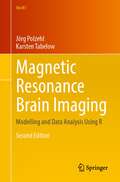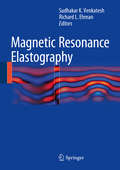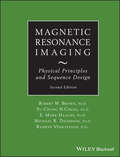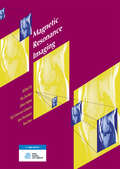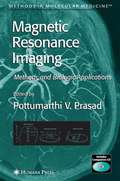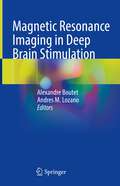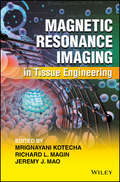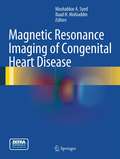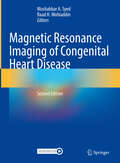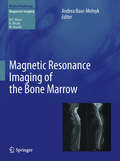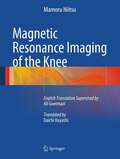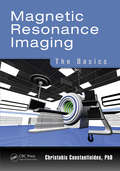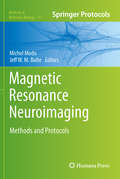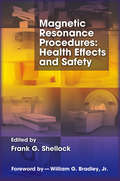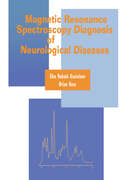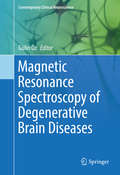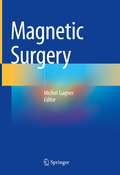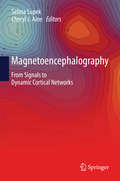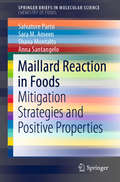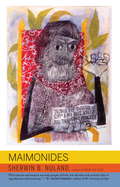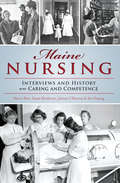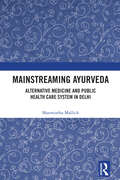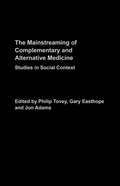- Table View
- List View
Magnetic Resonance Brain Imaging: Modelling and Data Analysis Using R (Use R!)
by Jörg Polzehl Karsten TabelowThis book discusses modelling and analysis of Magnetic Resonance Imaging (MRI) data of the human brain. For the data processing pipelines we rely on R, the software environment for statistical computing and graphics. The book is intended for readers from two communities: Statisticians, who are interested in neuroimaging and look for an introduction to the acquired data and typical scientific problems in the field and neuroimaging students, who want to learn about the statistical modeling and analysis of MRI data. Being a practical introduction, the book focuses on those problems in data analysis for which implementations within R are available. By providing full worked-out examples the book thus serves as a tutorial for MRI analysis with R, from which the reader can derive its own data processing scripts.The book starts with a short introduction into MRI. The next chapter considers the process of reading and writing common neuroimaging data formats to and from the R session. The main chapters then cover four common MR imaging modalities and their data modeling and analysis problems: functional MRI, diffusion MRI, Multi-Parameter Mapping and Inversion Recovery MRI. The book concludes with extended Appendices on details of the utilize non-parametric statistics and on resources for R and MRI data.The book also addresses the issues of reproducibility and topics like data organization and description, open data and open science. It completely relies on a dynamic report generation with knitr: The books R-code and intermediate results are available for reproducibility of the examples.
Magnetic Resonance Elastography
by Sudhakar K. Venkatesh Richard L. EhmanThe first book to cover the groundbreaking development and clinical applications of Magnetic Resonance Elastography, this book is essential for all practitioners interested in this revolutionary diagnostic modality. The book is divided into three sections. The first covers the history of MRE. The second covers technique and clinical applications of MRE in the liver with respect to fibrosis, liver masses, and other diseases. Case descriptions are presented to give the reader a hands-on approach. The final section presents the techniques, sequence and preliminary results of applications in other areas of the body including muscle, brain, lung, heart, and breast.
Magnetic Resonance Imaging
by E. Mark Haacke Robert W. Brown Ramesh Venkatesan Y.-C. Norman Cheng Michael R. ThompsonNew edition explores contemporary MRI principles and practicesThoroughly revised, updated and expanded, the second edition of Magnetic Resonance Imaging: Physical Principles and Sequence Design remains the preeminent text in its field. Using consistent nomenclature and mathematical notations throughout all the chapters, this new edition carefully explains the physical principles of magnetic resonance imaging design and implementation. In addition, detailed figures and MR images enable readers to better grasp core concepts, methods, and applications.Magnetic Resonance Imaging, Second Edition begins with an introduction to fundamental principles, with coverage of magnetization, relaxation, quantum mechanics, signal detection and acquisition, Fourier imaging, image reconstruction, contrast, signal, and noise. The second part of the text explores MRI methods and applications, including fast imaging, water-fat separation, steady state gradient echo imaging, echo planar imaging, diffusion-weighted imaging, and induced magnetism. Lastly, the text discusses important hardware issues and parallel imaging.Readers familiar with the first edition will find much new material, including:New chapter dedicated to parallel imagingNew sections examining off-resonance excitation principles, contrast optimization in fast steady-state incoherent imaging, and efficient lower-dimension analogues for discrete Fourier transforms in echo planar imaging applicationsEnhanced sections pertaining to Fourier transforms, filter effects on image resolution, and Bloch equation solutions when both rf pulse and slice select gradient fields are presentValuable improvements throughout with respect to equations, formulas, and textNew and updated problems to test further the readers' grasp of core conceptsThree appendices at the end of the text offer review material for basic electromagnetism and statistics as well as a list of acquisition parameters for the images in the book.Acclaimed by both students and instructors, the second edition of Magnetic Resonance Imaging offers the most comprehensive and approachable introduction to the physics and the applications of magnetic resonance imaging.
Magnetic Resonance Imaging
by Tom Dam José Dol-Jansen Sija Geers-van Gemeren Ria Zuurbier Johan NahuisIn dit boek worden de fysische en technische principes van MRI beschreven. Ook worden de meest voorkomende MRI-onderzoeken besproken, waarbij de relevante anatomie, pathologie en indicaties worden behandeld, evenals de positionering van de pati#65533;nt. Behalve voor MBB'ers (Medisch Beeldvormings- en Bestralingsdeskundigen) in opleiding, is Magnetic Resonance Imaging ook bij uitstek geschikt voor afgestudeerde MBB'ers die zich willen specialiseren op het gebied van MRI. Het boek is ook een goede introductie voor artsen in opleiding. Dit boek is een vervolg op, en afgeleid van de boeken 'Techniek in de radiologie' en 'Radiodiagnostisch onderzoek'. Vanaf 2010 zijn deze twee boeken vervangen door drie nieuwe delen, die sterk zijn uitgebreid en geactualiseerd: 'Computertomografie', 'Radiologie' en 'Magnetic Resonance Imaging'. Aan deze editie is een onlineomgeving StudieCloud toegevoegd. Via www. studiecloud. nl heeft de lezer toegang tot online verrijkingen, zoals toetsvragen en samenvattingen per hoofdstuk en deeplinks met betrouwbare informatie, samengesteld door de auteurs van het boek. 'Magnetic Resonance Imaging' maakt deel uit van de boekenserie Medische Beeldvorming en Radiotherapie. De uitgave van deze boeken is een initiatief van het project Samenwerkingsverband Leermiddelen, bestaande uit de redacties in samenwerking met auteurs uit het werkveld.
Magnetic Resonance Imaging
by Pottumarthi V. PrasadLeading experts in the use of MRI explain its basic principles and demonstrate its power to understand biological processes with numerous cutting-edge applications. To illustrate its capability to reveal exquisite anatomical detail, the authors discuss MRI applications to developmental biology, mouse phenotyping, and fiber architecture. MRI can also provide information about organ and tissue function based on endogenous cantrast mechanisms. Examples of brain, kidney, and cardiac function are included, as well as applications to neuro and tumor pathophysiology. In addition, the volume demonstrates the use of exogenous contrast material in functional assessment of the lung, noninvasive evaluation of tissue pH, the imaging of metabolic activity or gene expression that occur on a molecular level, and cellular labeling using superparamagnetic iron oxide contrast agents.
Magnetic Resonance Imaging in Deep Brain Stimulation
by Andres M. Lozano Alexandre BoutetThis book describes the roles magnetic resonance imaging (MRI) can play in deep brain stimulation (DBS). DBS therapeutically modulates aberrant neural circuits implicated in a broad range of neurological disorders. Following surgical insertion, an electrode placed into the desired brain target generates constant electricity, analogous to a cardiac pacemaker. Most commonly employed in movement disorders such as Parkinson’s disease, dystonia, and tremor, DBS is also being investigated for use in psychiatric and cognitive disorders, including depression and Alzheimer’s disease. It is estimated that more than 230,000 patients have undergone DBS surgery worldwide. Imaging techniques, specifically MRI, have played key roles in the preoperative and postoperative aspects of DBS. This book focuses on the established as well as the innovative roles of MRI in DBS. MRI and DBS are first introduced from an historical perspective and a review of the clinical aspects of DBS is performed. Then, the preoperative and postoperative applications of MRI in DBS are covered. The crucial aspect of MRI safety in these patients is also discussed. Finally, possible upcoming MRI applications for patients with DBS are discussed in a future directions chapter. Chapters are written by experts from the University of Toronto, a world leader in the field of DBS, alongside international co-authors to ensure a thorough review of the topics. This is an ideal guide for both clinicians (neurosurgeons, neurologists, psychiatrists, and neuroradiologists) and researchers as well as trainees interested in neuroimaging for DBS.
Magnetic Resonance Imaging in Movement Disorders
by Paul Tuite Alain DagherMagnetic Resonance Imaging in Movement Disorders is the first book to focus in detail on MRI in a range of movement disorders. Since MRI was first employed in imaging Parkinson's disease, the number of imaging techniques and their application in diagnosis and management has extended widely. The book shows various imaging strategies ranging from functional, structural and chemical methods as they relate to both motor and non-motor aspects of Parkinson's disease and other conditions such as Huntington's disease and dystonia. Chapters on MRI in surgery and using MRI as a potential outcome measure in clinical trials show the clinical relevance of methods. Novel methods including DTI, tractography and resting case studies are described in detail. The book also summarises the relevance of fMRI to various aspects of movement disorders. Magnetic Resonance Imaging in Movement Disorders is essential reading for neurologists, radiologists and movement disorder specialists.
Magnetic Resonance Imaging in Tissue Engineering
by Jeremy J. Mao Mrignayani Kotecha Richard L. MaginMagnetic Resonance Imaging in Tissue Engineering provides a unique overview of the field of non-invasive MRI assessment of tissue engineering and regenerative medicine Establish a dialogue between the tissue-engineering scientists and imaging experts and serves as a guide for tissue engineers and biomaterial developers alike Provides comprehensive details of magnetic resonance imaging (MRI) techniques used to assess a variety of engineered and regenerating tissues and organs Covers cell-based therapies, engineered cartilage, bone, meniscus, tendon, ligaments, cardiovascular, liver and bladder tissue engineering and regeneration assessed by MRI Includes a chapter on oxygen imaging method that predominantly is used for assessing hypoxia in solid tumors for improving radiation therapy but has the ability to provide information on design strategies and cellular viability in tissue engineering regenerative medicine
Magnetic Resonance Imaging of Congenital Heart Disease
by Mushabbar A. Syed Raad H. MohiaddinThis textbook is alone in focusing on the subject of cardiac magnetic resonance (CMR) imaging in pediatric and adult patients with congenital heart disease. The topic of congenital heart disease imaging is usually relegated to a single chapter in most general CMR texts. The expanding scope of CHD warrants a text dedicated to covering CHD and CMR imaging in detail. Our proposed book aims to be a comprehensive and authoritative text on this subject. This book is be a multi-authored, illustrated text that includes supplementary access to a number of clinical videos. Authors have been selected from imaging experts in the most medically advanced areas of the world, heavily weighted by experts in the US and Europe to produce the quintessential reference in this topic.
Magnetic Resonance Imaging of Congenital Heart Disease
by Mushabbar A. Syed Raad H. MohiaddinThis heavily updated textbook focuses on the use of cardiac magnetic resonance (CMR) imaging in pediatric and adult patients with congenital heart disease. Over past two decades, CMR has come to occupy an ever more important place in the assessment and management of patients with congenital heart defects (CHD) and other cardiovascular disorders. The modality offers an ever-expanding amount of information about the heart and circulation, provides outstanding images of cardiovascular morphology and function, is increasingly being used to detect pathologic fibrosis, and has an expanding role in the assessment of myocardial viability. Magnetic Resonance Imaging of Congenital Heart Disease is an excellent foundation for any reader not familiar with the field whether they are imagers or clinicians who deal with cardiovascular disease. It also describes the technical details of MRI techniques to help the clinician understand the most important elements of CMR in assessing and managing their patients. In creating the book, the editors have assembled a world-renowned panel of contributors to review the use of CMR in CHD and make it accessible to those working in the field and to those who use the information derived from CMR in their clinical practice.
Magnetic Resonance Imaging of the Bone Marrow
by Andrea Baur-MelnykOn account of its unrivalled imaging capabilities and sensitivity, magnetic resonance imaging (MRI) is considered the modality of choice for the investigation of physiologic and pathologic processes affecting the bone marrow. This book describes the MRI appearances of both the normal bone marrow, including variants, and the full range of bone marrow disorders. Detailed discussion is devoted to malignancies, including multiple myeloma, lymphoma, chronic myeloproliferative disorders, leukemia, and bone metastases. Among the other conditions covered are benign and malignant compression fractures, osteonecrosis, hemolytic anemia, Gaucher's disease, bone marrow edema syndrome, trauma, and infective and non-infective inflammatory disease. Further chapters address the role of MRI in assessing treatment response, the use of contrast media, and advanced MRI techniques. Magnetic Resonance Imaging of the Bone Marrow represents an ideal reference for both novice and experienced practitioners.
Magnetic Resonance Imaging of the Knee
by Ali Guermazi Daichi Hayashi Mamoru NiitsuThis abundantly illustrated atlas of MR imaging of the knee documents normal anatomy and a wide range of pathologies. In addition to the high-quality images, essential clinical information is presented in bullet point lists and diagnostic tips are included to assist in differential diagnosis. Concise explanations and guidance are also provided on the MR pulse sequences suitable for imaging of the knee, with identification of potential artifacts. This book will be an invaluable asset for busy radiologists, from residents to consultants. It will be ideal for carrying at all times for use in daily reading sessions and is not intended as a reference to be read in the library or in non-clinical settings.
Magnetic Resonance Imaging: The Basics (Latest Advances In Clinical And Pre-clinical Cardiovascular Magnetic Resonance Imaging Ser.)
by Christakis ConstantinidesMagnetic resonance imaging (MRI) is a rapidly developing field in basic applied science and clinical practice. Research efforts in this area have already been recognized with five Nobel prizes awarded to seven Nobel laureates in the past 70 years. Based on courses taught at The Johns Hopkins University, Magnetic Resonance Imaging: The Basics provides a solid introduction to this powerful technology. <P><P>The book begins with a general description of the phenomenon of magnetic resonance and a brief summary of Fourier transformations in two dimensions. It examines the fundamental principles of physics for nuclear magnetic resonance (NMR) signal formation and image construction and provides a detailed explanation of the mathematical formulation of MRI. Numerous image quantitative indices are discussed, including (among others) signal, noise, signal-to-noise, contrast, and resolution. The second part of the book examines the hardware and electronics of an MRI scanner and the typical measurements and simulations of magnetic fields. It introduces NMR spectroscopy and spectral acquisition and imaging techniques employing various pulse sequences. The final section explores the advanced imaging technique of parallel imaging. Structured so that each chapter builds on the knowledge gained in the previous one, the book is enriched by numerous worked examples and problem sets with selected solutions, giving readers a firm grasp of the foundations of MRI technology.
Magnetic Resonance Neuroimaging
by Jeff W.M. Bulte Michel ModoThe advent of non-invasive imaging technology, such as magnetic resonance imaging (MRI), has allowed biologists and clinicians to make great strides in unraveling the secrets of the brain. In Magnetic Resonance Neuroimaging: Methods and Protocols, expert researchers in the field provide a comprehensive collection of experimental MRI protocols that can be used to non-invasively interrogate the healthy and diseased brain. The chapters are divided into general techniques, such as the measurement of relaxivity, magnetic resonance spectroscopy, diffusion tensor imaging, and MR reporter genes, as well as specific applications in brain imaging, for example, phenotyping transgenic animals, detecting amyloid plaques, and fMRI in psychiatry. As a volume in the highly successful Methods in Molecular BiologyTM series, this work contains the type of detailed description and implementation advice that is crucial for getting optimal results. Thorough and cutting-edge, Magnetic Resonance Neuroimaging: Methods and Protocols serves neuroscientists, clinical neurologists, psychiatrists, and radiologists with an excellent compendium of methods easily applied to both animal and human studies and certain to be an excellent resource for translational research.
Magnetic Resonance Procedures: Health Effects and Safety
by Frank G. ShellockMagnetic Resonance Procedures: Health Effects and Safety is the first authoritative text on MR procedures and its associated health and safety concerns written by noted radiologists, physicists, and scientists with expertise in the field. It contains both theoretical and practical information. This timely text discusses emergent issues rela
Magnetic Resonance Spectroscopy Diagnosis of Neurological Diseases
by Else Rubæk Danielsen Brian RossDemonstrates how MRS offers a useful tool for the noninvasive biochemical analysis of the brain. The book covers over 70 clinical cases and more than 100 spectra that enhance skills at interpreting MRS, including minimizing errors, highlighting artifacts, and expanding the clinical usefulness of this diagnostic modality.
Magnetic Resonance Spectroscopy of Degenerative Brain Diseases
by Gülin ÖzThe proposed book will act as a guide for scientists and clinicians to the unique information that MRS can provide. It will be a comprehensive overview of clinical and pre-clinical MRS applications and potential clinical utility of MRS biomarkers in degenerative brain diseases from leading experts in the field. MRS has proven to be a powerful complementary tool to MRI for the diagnosis and monitoring of disease progression and response to treatment because it can detect changes in cell density, cell type, and biochemical composition, not just structural changes. As the population in the developed world continues to age, neuroimaging for diagnosis, prognosis, and therapy monitoring of neurodegenerative diseases becomes increasingly important and there has been a recent surge of clinical and pre-clinical applications of MRS indicating that this technique can provide robust and non-invasive biomarkers of degeneration.
Magnetic Resonance Spectroscopy of Degenerative Brain Diseases (Contemporary Clinical Neuroscience)
by Gülin ÖzThe proposed book will act as a guide for scientists and clinicians to the unique information that MRS can provide. It will be a comprehensive overview of clinical and pre-clinical MRS applications and potential clinical utility of MRS biomarkers in degenerative brain diseases from leading experts in the field. MRS has proven to be a powerful complementary tool to MRI for the diagnosis and monitoring of disease progression and response to treatment because it can detect changes in cell density, cell type, and biochemical composition, not just structural changes. As the population in the developed world continues to age, neuroimaging for diagnosis, prognosis, and therapy monitoring of neurodegenerative diseases becomes increasingly important and there has been a recent surge of clinical and pre-clinical applications of MRS indicating that this technique can provide robust and non-invasive biomarkers of degeneration.
Magnetic Surgery
by Michel GagnerThe book encompasses the different concepts and designs using magnets for surgical purposes. It provides a concise yet comprehensive summary of the current status of the field that will help guide patient management and stimulate investigative efforts. The text reviews new data about interventions in all medical and surgical fields. Written by experts in their fields, topics focus on endoluminal and laparoscopic operations, techniques from vascular and GI anastomosis. The book demonstrates the use of magnets to treat a variety of diseases such as reflux, back pain, and fecal incontinence. The reader will learn how to retract and gain exposure, dissect tissue planes, achieve hemostasis, and create anastomosis in a totally different way. Physical properties of external surface and internal magnets are discussed. The authors emphasize the importance of partnering with industry leaders to develop novel surgical tools.By harnessing the power of attraction, the energy and might of magnets, Magnetic Surgery serves as a valuable resource for clinicians, surgeons and researchers in biomedical engineering interested in this form of energy and physical metal properties. In utilizing these properties, the book seeks to improve surgical outcomes of patients worldwide.
Magnetoencephalography
by Selma Supek Cheryl J. AineMagnetoencephalography (MEG) is an invaluable functional brain imaging technique that provides direct, real-time monitoring of neuronal activity necessary for gaining insight into dynamic cortical networks. Our intentions with this book are to cover the richness and transdisciplinary nature of the MEG field, make it more accessible to newcomers and experienced researchers and to stimulate growth in the MEG area. The book presents a comprehensive overview of MEG basics and the latest developments in methodological, empirical and clinical research, directed toward master and doctoral students, as well as researchers. There are three levels of contributions: 1) tutorials on instrumentation, measurements, modeling, and experimental design; 2) topical reviews providing extensive coverage of relevant research topics; and 3) short contributions on open, challenging issues, future developments and novel applications. The topics range from neuromagnetic measurements, signal processing and source localization techniques to dynamic functional networks underlying perception and cognition in both health and disease. Topical reviews cover, among others: development on SQUID-based and novel sensors, multi-modal integration (low field MRI and MEG; EEG and fMRI), Bayesian approaches to multi-modal integration, direct neuronal imaging, novel noise reduction methods, source-space functional analysis, decoding of brain states, dynamic brain connectivity, sensory-motor integration, MEG studies on perception and cognition, thalamocortical oscillations, fetal and neonatal MEG, pediatric MEG studies, cognitive development, clinical applications of MEG in epilepsy, pre-surgical mapping, stroke, schizophrenia, stuttering, traumatic brain injury, post-traumatic stress disorder, depression, autism, aging and neurodegeneration, MEG applications in cognitive neuropharmacology and an overview of the major open-source analysis tools.
Maillard Reaction in Foods: Mitigation Strategies and Positive Properties (SpringerBriefs in Molecular Science)
by Salvatore Parisi Sara M. Ameen Anna Santangelo Shana MontaltoThis book provides an overview of mitigation strategies and positive health effects of Maillard Reaction products in the contexts of food processing and storage. The effects of Maillard Reactions can vary considerably: while on the one hand certain sensorial alterations and influences on color, flavor and odor may be desirable, Maillard Reactions can also result in potentially harmful and toxic products (e.g. furfurals, furosines, or acrylamide). This book discusses possible mitigation strategies for the reduction of toxic reaction products, including the addition of enzymes or antioxidants, reducing sugars, and encapsulation approaches, as well as new processing strategies, such as high-pressure, radio-frequency, ultrahigh-temperature, or Ohmic heating methods. The book also illustrates that certain Maillard products can even produce positive health effects, e.g. antimicrobial or anticarcinogenic effects. The methods described here can serve as a blueprint for promoting the formation of beneficial compounds and reducing / avoiding toxic substances, offering essential strategies and methods.
Maimonides
by Sherwin B. NulandMoses Maimonides was a Renaissance man before there was a Renaissance: a great physician who served a sultan, a dazzling Torah scholar, a community leader, a daring philosopher whose greatest work--The Guide for the Perplexed--attempted to reconcile scientific knowledge with faith in God. He was a Jew living in a Muslim world, a rationalist living in a time of superstition. Eight hundred years after his death, his notions about God, faith, the afterlife, and the Messiah still stir debate; his life as a physician still inspires; and the enigmas of his character still fascinate. Sherwin B. Nuland, best-selling author of How We Die, focuses his surgeon's eye and writer's pen on this greatest of rabbis, most intriguing of Jewish philosophers, and most honored of Jewish doctors. He gives us a portrait of Maimonides that makes his life, his times, and his thought accessible to the general reader as they have never been before.
Maine Nursing: Interviews and History on Caring and Competence
by Susan Henderson Valerie Hart Juliana L'Heureux Ann SossongMaine nurses have served tirelessly as caregivers and partners in healing at home and abroad, from hospitals to battlefields. The Division of Public Health Nursing and Child Hygiene was established in 1920 to combat high rates of infant mortality in Washington and Aroostook Counties. During the Vietnam War, Maine nurses helped build the Twelfth Evacuation Hospital at Cu Chi and bravely assisted surgeries in the midst of fighting. In the early 1980s, nurse disease prevention educators in Portland rose to the challenge of combating the growing AIDS epidemic. Through historical anecdotes and fascinating oral histories, discover the remarkable sacrifices and achievements of Maine's nurses.
Mainstreaming Ayurveda: Alternative Medicine and Public Health Care System in Delhi
by Sharmistha MallickThis book brings concepts, practices of Ayurveda and its interface with modern health care set-up in Delhi, India. It presents a new conceptual framework in studying public health in India, offers policy recommendations and outlines the challenges of mainstreaming of alternative medical systems in India.Drawing on a wealth of primary data that looks at the social profile of patients, gender, disease profile of patients, prescriptions, average cost per prescription and kinds of medicines prescribed, the monograph explores patterns of health behaviour through the perceptions of doctors and patients, administrators and their negotiations with the bureaucratic health structure. It analyses the power and structures between practitioners of modern medicine and Ayurvedic doctors and the issues of cross referral and formal and informal levels of interaction/network between the two medical systems. Engaging with current debates around public health in India, the volume will be of interest to scholars and researchers of public health and sociology of health and medicine, public policy and public administration and South Asian studies.
Mainstreaming Complementary and Alternative Medicine: Studies in Social Context
by Jon Adams Gary Easthope Philip ToveyStepping back from the immediate demands of policy-making, Mainstreaming Complementary and Alternative Medicine allows a complex and informative picture to emerge of the different social forces at play in the integration of CAM with orthodox medicine. Complementing books that focus solely on practice, it will be relevant reading for all students following health studies or healthcare courses, for medical students and medical and healthcare professionals.
